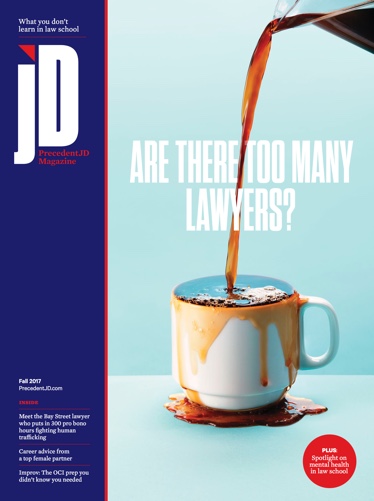
If you want to grab a law student’s attention, mention the Bay Street job market. After all, for a decent chunk of them, working there is the ultimate goal. And over the past decade, as the pool of jobs has shrunk, it’s been particularly easy to obsess over this subject.
But — surprise! — this past year’s job numbers were terrific. For the 2015–16 articling term, the 16 Bay Street firms that have historically hired the most students took on 255, according to exclusive numbers that PrecedentJD collects each year. But for the 2016–17 cohort, those same firms hired 259 students. This figure sat at 325 in 2009, but a small increase, after years of decline, matters.
What’s more, those firms hired back 218 of their articling students as first-year associates. That’s a huge increase over the 188 students they hired back last year.
“The economy is picking up and firms are busier,” explains Shannon Leo, the director of associate and student programs at Cassels Brock & Blackwell LLP. Cassels, in fact, had a banner year: it hired back all 12 of its articling students, reporting, for the first time, a 100-percent hireback rate. Because firms are busy, adds Leo, they need associates to meet the current demand.
Which raises a delicate question: is the legal market about to take off and create jobs for students along the way? Don’t count on it.
Jordan Furlong, founder of the legal-consultancy firm Law21, sees this year’s uptick as an anomaly. “Unless firms continue to bring in enough work to profitably feed their associates,” he says, “I expect that, in three years’ time, the overall number of first-year associates at these firms will once again be in steady decline.”
The main reason, he explains, is that large law firms will continue to outsource — both to technology and low-cost centres — routine legal work, such as document review and due diligence, that they once assigned to students and associates. “The model is changing,” he says. “Rather than having an associate who’s making 80 to a 100 grand a year, many firms will turn to software programs or good freelance lawyers. Neither one carries the same salary or secretarial overhead.” One good year in the legal market, he insists, will not disrupt this “irreversible” trend.
Over at Cassels, Leo is optimistic about the next 12 months, but she makes no promises about the following year. “I would love for this year’s hireback results to be a continuing trend,” she says. “But it’s hard to predict.”
The spectacular now
This firm-by-firm breakdown of Bay Street’s articling-student job market shows that, in the past year, the overall hireback rate has soared.
| Firm | Number of articling students in 2016 | Number of articling students in 2017 | Hireback rate in 2016 | Hireback rate in 2017 |
|---|---|---|---|---|
| Bennett Jones | 16 | 18↑ | 93% | 67% ↓ |
| Blakes | 32 | 24↓ | 86% | 96% ↑ |
| BLG | 21 | 19 ↓ | 70% | 89% ↑ |
| Cassels | 17 | 12 ↓ | 88% | 100% ↑ |
| Davies | 11 | 14 ↑ | 90% | 89% ↓ |
| Dentons | 14 | 12 ↓ | 69% | 64% ↓ |
| Department of Justice | 4 | 10 ↑ | 100% | 100% = |
| Faskens | 12 | 12 = | 82% | 100% ↑ |
| Goodmans | 13 | 15 ↑ | 100% | 93% ↓ |
| Gowlings WLG | 16 | 13 ↓ | 60% | 62% ↑ |
| McCarthys | 20 | 20 = | 94% | 89% ↓ |
| McMillan | 11 | 12 ↑ | 60% | 92% ↑ |
| Norton Rose | 20 | 17 ↓ | 63% | 75% ↑ |
| Osler | 16 | 20 ↑ | 93% | 100%↑ |
| Stikemans | 17 | 24↑ | 87% | 100% ↑ |
| Torys | 15 | 17 ↑ | 100% | 94% ↓ |
| Total | 255 | 259 ↑ | 82% | 89% ↑ |

This story is from the 2017 edition of PrecedentJD Magazine
